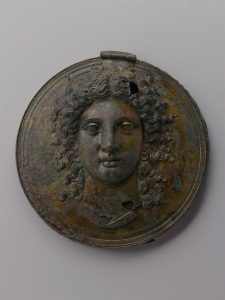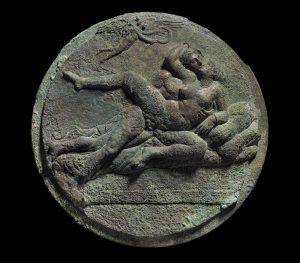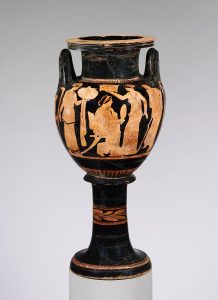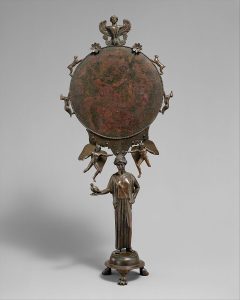21 Recasting a Woman’s Role: The Bronze Mirror as a Tool for Self-Agency
Brianne Bousfield
In myth, Narcissus becomes mesmerized by his reflection, falling so deeply in love with his image that he loses all sense of reality. This myth is a powerful testament to our image and reflection’s ability to captivate, empower, and even consume. In ancient Greece, mirrors were not simply objects for self-admiration; they were instruments that allowed women to shape their own identities, control their beauty, and assert power in a world that often sought to define them. Through the reflective surface of bronze mirrors, women found a way to engage with their own image and, by extension, their place in society—transforming a tool of vanity into one of agency.
In ancient Greece, mirrors were typically crafted from polished bronze, a material prized for its reflective qualities and aesthetic appeal. In Aristophanes’ Women at the Thesmophoria, mirrors are explicitly associated with women, offering a glimpse into how deeply embedded they were in their daily lives and rituals in ancient Greek society. In the play, mirrors are mentioned as part of a woman’s essential kit, intimately tying them to the lives of women and serving as essential tools for personal grooming (Aristoph. Thes. 140). While mirrors were functional, women’s use of mirrors was not just for personal vanity but was embedded in their daily rituals of beauty and in religious and social practices. Mirrors, therefore, become a powerful lens through which we can explore how women in Ancient Greece experienced agency and control over their lives.
Types of Greek Mirrors
There were three main types of bronze mirrors in ancient Greece: the handheld mirror, the caryatid mirror, and the box mirror. While each of these mirrors was different in form, they were pivotal in allowing women to engage with their own image and, by extension, their power and agency.
Handheld Mirrors were the most common form. These small, portable mirrors were often held by the user, allowing them to examine themselves up close. Handheld mirrors were both practical and intimate, offering women the chance to groom themselves and adjust their appearance in the privacy of their own space.
Caryatid Mirrors, a less common but significant form, was often large and fixed to a vertical stand. These mirrors were typically supported by statues of women, known as caryatids, who were elegantly draped and often posed with a sense of grace. These mirrors were symbols of wealth and status, and they were more frequently found in the homes of the elite.
Box Mirrors have no handles or stands; instead, these mirrors have covers that fold or fit over the reflective surface. Their design has weight and depth and closely resembles a pyxis (on which see chapter 20). Box mirrors were extremely popular, if cumbersome to hold (as shown in this linked image), and were therefore not direct parallels to today’s compact mirror; instead, the box mirror remained in the private space.
Sexual Agency
Beauty was an essential part of women’s social capital, and they could engage with and perfect their physical form through the mirror. Magnifying beauty through cosmetics , hair, or jewelry provided women with an element of power in a society where physical appearance was often a reflection of a woman’s status and virtue. Mirrors allowed them to exert a degree of control over their appearance, which could influence how they were seen in such a patriarchal society.
The iconography found on bronze mirrors is crucial in understanding how women’s sexual agency was symbolically constructed in Ancient Greece. The designs on these mirrors often included representations of goddesses, mythical figures, and scenes of sensual, or romantic encounters. Some of the most common motifs were depictions of goddesses such as Aphrodite, the goddess of love and beauty, who was often portrayed with an emphasis on her physical beauty and sexual allure. By decorating mirrors this way, women could align themselves with divine beauty, take inspiration, and model themselves after the goddess.

The imagery on these mirrors often reinforced the connection between beauty and sexuality. The box mirror to the right (Fig. 21.1) shows the face of a woman surrounded by flowing hair. This image could parallel what a woman might have seen when she opened the lid. Given the erotic connotations of hair (see chapter 9), the case may emphasize the seductive power of hair and how styling it in front of a mirror can enhance one’s allure. The iconography thus not only acts as a reflection of the viewer’s physical beauty but also symbolizes a deeper connection to sexuality and power. This private, intimate object provided a sense of empowerment by fostering a woman’s self-image and allowing her to assert her agency—not merely as an object of male desire but as a subject in her own right.
The Mirror and the Erotic
As a later example, this box mirror stands out for its explicit erotic imagery: it depicts a man and woman engaged in lovemaking on the exterior, while another amorous couple is engraved beneath the silver coating. This mirror has been associated with Leaina, a hetaira (sex labourer) famed for her bold sexual persona, particularly the “lioness” position, which is graphically illustrated on the mirror’s cover.

This unique object holds significant meaning in terms of women’s sexual agency. Traditionally, ancient Greek culture depicted women as passive sexual objects, with little room for their own sexual autonomy or assertion. The explicit sexual imagery of this mirror challenges these gender norms, offering a rare glimpse into the sexual assertiveness of a woman. The mirror’s owner, likely a woman of considerable wealth, would have gazed upon these scenes with an empowered awareness of her sexuality. The mirror, therefore, symbolizes not just a tool for personal reflection, but also a statement of sexual agency, presenting a woman not as an object of desire but as an active, assertive participant in her own erotic narrative.
Economic Agency
Mirrors were also tied to economic power. The value and craftsmanship of the mirror meant that a mirror would have been gifted to a woman; either from a male client to a favoured hetaira or given to a woman entering marriage. As part of a woman’s dowry, mirrors were symbols of wealth and social standing. Dowries, given by a woman’s family to her husband upon marriage, often included objects that signified the family’s prosperity. The role of mirrors in dowries underscored their importance as not just personal objects but also as economic instruments in securing a woman’s place in marriage. A woman’s dowry was often an important factor in determining the terms of the marriage contract, and the items included in the dowry were carefully chosen to reflect the economic stability and social status of her family. The presence of a finely made mirror in a dowry would signify that the family could afford such luxuries, which could, in turn, elevate the perceived worth of the woman in the eyes of her potential suitor and his family. A mirror could also be a gift from the groom to his future bride. This symbolized the woman’s beauty and the role she was expected to play in the household. Mirrors, in this context, not only represented feminine beauty but also reinforced the social expectations placed upon women as wives, mothers, and caregivers.

In Greek art, like the image on the left (Fig. 21.3), women are often depicted with mirrors in scenes of personal adornment and wedding preparation, highlighting how closely linked they are. In this way, mirrors functioned as both a practical and symbolic asset, tying women to a network of wealth, prestige, and family legacy. When presented as part of a dowry, a mirror was a reflection of her family’s ability to participate in the larger economic and social systems of the Greek world.
The mirror being made of bronze is also significant as this was a metal traditionally associated with warfare, power, and masculinity (see chapter 8); therefore, the possession of bronze carried a certain prestige. While women were largely excluded from the world of public power and independence, the presence of a bronze mirror as a part of their personal belongings afforded them a connection to the masculine economic sphere.
Religious Agency

In addition to their everyday use, bronze mirrors played a significant role in ancient Greek religious and ritualistic practices. Mirrors were commonly associated with the divine, particularly with goddesses like Aphrodite, the goddess of beauty, love, and sexuality. The symbolism of mirrors in these contexts was multifaceted—representing beauty and femininity as well as the connection between the mortal and divine realms (Paus. 7.21.12). Mirrors were often used in religious ceremonies or offered as votive gifts to the gods, particularly in temples dedicated to Aphrodite or other fertility and beauty deities. The act of dedicating a mirror in a temple could signify a woman’s devotion to the goddess or her desire for beauty, fertility, and protection.
Mirrors were also components in purification and cleansing rituals. For example, mirrors could be used in rites of passage, such as the transition from childhood to adulthood, or rituals marking important events like marriage. These ceremonies often involved beauty-related practices, such as the use of cosmetics and adornment, and the mirror functioned as a tool for self-presentation, reinforcing the connection between the self, beauty, and divine favor.
Concluding Thoughts
Greek bronze mirrors provided women with a means of self-representation and agency, allowing them to assert control over their identities and appearances. Mirrors transcended their practical function as symbols of beauty, status, and power and became key instruments in the complex landscape of women’s lives in ancient Greece.
Bibliography and Further Reading
Boymel Kampen, N. 2000. “Gender and Desire.” In Naked Truths: Women, Sexuality and Gender in Classical Art and Archaeology, edited by A. O. Koloski-Ostrow and C. L. Lyons, 267–77. London: Routledge.
Cerqueira, F. V. 2018. “Erotic Mirrors. Eroticism in the Mirror. An Iconography of Love in Ancient Greece (Fifth to Fourth Century B.C.).” Heródoto: Revista do Grupo de Estudos e Pesquisas sobre a Antiguidade Clássica e suas Conexões Afro-asiáticas 3.1: 153–87.
Lee, M. M. 2017. “The Gendered Economics of Greek Bronze Mirrors: Reflections on Reciprocity and Feminine Agency.” Arethusa 50: 143–68.
Reggiani, N. 2021. “Mirrors of Women, Mirrors of Words: The Mirror in the Greek Papyri.” In Mirrors and Mirroring from Antiquity to the Early Modern Period, edited by M. Gerolemou and L. Diamantopoulou, 59–71. London: Bloomsbury Academic.
Stewart, A. 1996. “Reflections.” In Sexuality in Ancient Art, edited by N. Boymel Kampen, 136–54. Cambridge: Cambridge University Press.

